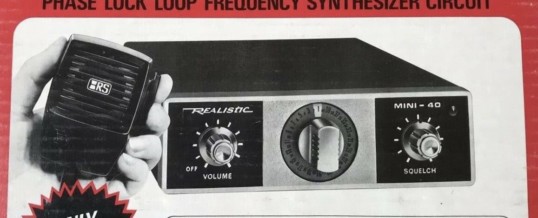
Before there was Facebook, there was the CB radio. It was how Americans talked to each other.
During a few years in the 1970s, the CB radio, short for citizens band, was about as big as social media is today. We didn’t need the 10 o’clock news to tell us what was going on, we had each other. By purchasing a base radio for your home or a mobile radio for your vehicle, you could key the mic and talk to someone you knew – or someone you didn’t.
It was a blast.
Everyone used a nickname, which was called a ‘handle.’ Often, the handle a person selected had to do with their lifestyle, profession, or hobby.
You knew who was on the radio by their voice and handle. “Barefoot,” “Hollywood,” Whiskey Man,” and other folks, would fill you in on the latest news in your hometown – or the world.
If you had a high-powered base unit in your house, you could talk great distances. But, most people had a mobile unit and talked while they drove to and from work, church or another destination.
“Breaker, breaker, good buddy. Anyone got their ears on?” would be the way people started a conversation. You could also try and reach someone using their handle.
“Hey, this is Hollywood. What about that Barefoot? You got your ears on?”
“Yeah, Hollywood, this is Barefoot. What’s your 20?”
“I’m in front of Lacy Harris’ palace. I’ll meet you at Miss Mac’s for a hot steak sandwich in 30. That work?”
“10-4, Barefoot. Hollywood clear.”
The radio lingo was based on a mixture of a home-cooked vernacular and the 10-codes. The 10-codes are a way of quickly communicating common messages and included 10-20 (a person’s location), 10-4 (acknowledged), or other codes used to make things concise.
The early radios had 21 channels, but the popularity of CBs caught on almost overnight. When millions of people began flooding the offices of the Federal Communications Commission with requests for a CB license, the FCC expanded the number of channels on the radios to 40. Still overwhelmed, the FCC eventually did away with the license requirement and anyone could buy a radio, and talk to anyone they liked, on any channel they liked, anytime they liked.
Drivers of semi trucks used channel 19. Other channels were used at the discretion of the radio operator.
It was a great thing to witness. People were communicating.
For those who weren’t here to see the phenomenon that was the citizen’s band radio, is difficult to paint a picture of how ubiquitous CB radios were.
It was rare to drive down the road and not see an antenna attached to virtually every car or truck. As you passed a Pontiac, Ford, Oldsmobile, or other vehicle, the CB antenna would look as if it were lying down behind the vehicle as it was bent by the wind as the owner sped down the highway.
Many movies released during the 70s include the use of CBs. Probably the most popular was “Smokey and The Bandit.” It’s hard to imagine Burt Reynolds driving that Trans Am with the steering wheel in one hand and without that CB microphone in the other.
My father had a radio mounted under the metal dash in his 1966 Ford Mustang. He had a wire that ran from the radio, under the carpet, and under the back seat into the rear compartment, where it connected to an antenna that was mounted on his trunk lid.
On many trips, I listened to my father talk with his friends. Mostly, they talked about a lot of nothing. But they weren’t fighting about politics or religion. They weren’t calling each other names.
Conversations were often the same type of benign chatter as is seen on Facebook today. Talk about the latest movies or TV shows, or upcoming events were what most people discussed.
One significant difference between CB radios in the 1970s and social media today is that on the CB, no one would have ever thought to attack someone for their political or religious views.
Unlike so much of what you see on social media today, where people are screaming at each other and unsuccessfully trying to change other people’s opinions. On the CB radio, my dad and other Americans were just communicating and having fun. It was friendly. It was healthy. It was good.
People were nice to each other. They helped each other.
And I miss that a lot, good buddy.
©2019 John Moore
John’s book, Write of Passage: A Southerner’s View of Then and Now, is available on Amazon and Barnes and Noble. You can reach John through his website at www.TheCountryWriter.com.
JUL
2019
